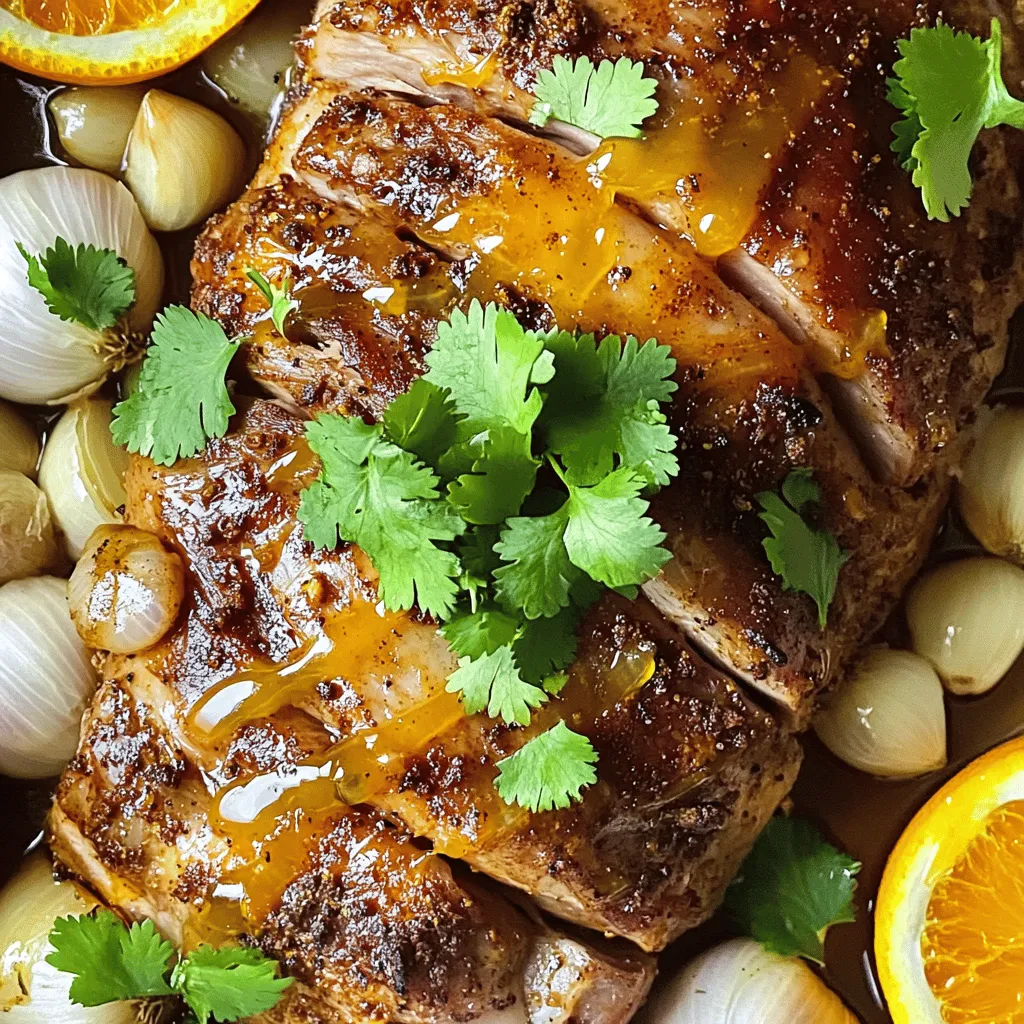Slow-cooked pork shoulder is a game-changer for your dinner table. This dish delivers juicy, tender meat packed with flavor. Whether it’s a cozy family meal or a gathering with friends, your taste buds are in for a treat. In this post, I’ll guide you through the steps to create the perfect pork shoulder. Get ready to impress your guests with this easy, delightful recipe!
Ingredients
Essential Ingredients
– 3-4 lbs pork shoulder, bone-in
– Spices:
– 1 tablespoon smoked paprika
– 1 tablespoon ground cumin
– 1 tablespoon garlic powder
– 2 teaspoons onion powder
– 2 teaspoons dried oregano
– 1 teaspoon cayenne pepper (adjust for heat)
– 1 teaspoon salt
– 1 teaspoon black pepper
– Liquids:
– 1 cup low-sodium chicken broth
– 1 cup orange juice (freshly squeezed for best flavor)
– 2 tablespoons apple cider vinegar
– Aromatics:
– 1 onion, coarsely chopped
– 6 cloves garlic, whole
– Fresh Ingredients:
– 2 tablespoons olive oil
– Fresh cilantro, for garnish
The pork shoulder is the star of this dish. It has fat and collagen, which makes it juicy and tender. The seasoning is key. Use smoked paprika for a deep flavor and cumin for warmth. Garlic powder and onion powder add depth. Cayenne pepper brings heat, but you can adjust it to your taste.
The liquids work together to make a tasty sauce. Chicken broth adds richness, while orange juice gives a bright note. Apple cider vinegar balances the flavors. The onion and garlic add great aroma and taste as they cook down.
Fresh cilantro is perfect for garnish. It adds a pop of color and a fresh taste. You can find all these ingredients in your local grocery store.
Step-by-Step Instructions
Preparing the Spice Rub
To start, gather your spices. In a small bowl, combine the smoked paprika, ground cumin, garlic powder, onion powder, dried oregano, cayenne pepper, salt, and black pepper. Mixing these spices well is key. This ensures an even flavor on the pork. A good spice rub can make a big difference in taste.
Seasoning the Pork
Next, take your pork shoulder and pat it dry with paper towels. This step helps the spice rub stick better. Now, rub the spice mixture all over the pork. Make sure it covers all sides. For the best flavor, let it marinate for at least 30 minutes. If you have time, marinate it overnight in the fridge. This will deepen the flavors.
Cooking Techniques
Now, let’s sear the pork shoulder. In a large skillet or Dutch oven, heat the olive oil over medium-high heat. Once hot, add the seasoned pork. Sear it on each side until it is browned, about 4-5 minutes per side. This step locks in juices and adds a nice crust.
After searing, transfer the pork to the slow cooker. Add the chopped onion and whole garlic cloves around the pork. Pour in the chicken broth, orange juice, and apple cider vinegar. These liquids will add moisture and flavor as the pork cooks. Now, cover the slow cooker and set it to low heat. Cook for 8 to 10 hours. The pork will become tender and pull apart easily.
Tips & Tricks
Cooking Times
For the best results, slow-cook your pork shoulder for 8 to 10 hours on low heat. This long cooking time breaks down the tough meat fibers for a tender bite. To check for tenderness, use a fork. If the meat pulls apart easily, it’s ready. If it’s still tough, let it cook longer.
Flavors and Seasoning Adjustments
You can adjust the heat by adding more cayenne pepper. If you like it spicy, feel free to double the amount. On the other hand, if you prefer milder flavors, leave it out altogether. Also, try using different liquids. Swap orange juice for pineapple juice for a sweet twist. You could even use beer or cider to change the flavor profile.
Equipment Recommendations
A good slow cooker makes all the difference. Look for one with a locking lid to keep moisture in. If you don’t have a slow cooker, don’t worry! You can use a Dutch oven or a heavy pot. Just make sure to cover it well and cook it on low heat in the oven. This method can also yield great results.

Variations
Flavor Profile Adjustments
You can change the taste of your slow-cooked pork shoulder by adding spices. Try using different seasonings like chili powder or coriander. Each spice brings its own flavor. You might enjoy a bit of sweetness with cinnamon or a touch of herbiness with thyme.
Adding fruits or vegetables also enhances the dish. Pineapple or apple slices add a sweet twist. You could even add carrots or bell peppers for a veggie boost. These additions can create a unique taste that suits your palate.
Serving Options
You can enjoy slow-cooked pork shoulder in many ways. Serve it in tacos for a fun meal. Add fresh salsa and avocado for extra flavor. You might also try it in sandwiches, piled high with coleslaw.
Over rice, the pork makes a hearty dish. The sauce from the slow cooker pairs well with grains. For sides, consider roasting vegetables or making a fresh salad. Cornbread or baked beans are also great choices.
Leftover Ideas
Leftover pork shoulder can be a treasure. Shred it and use it in tacos or burritos. You could also make a tasty BBQ pork sandwich.
If you have more leftovers, try making soup. Combine the pork with broth, beans, and veggies for a filling meal. Another idea is to create a casserole. Mix it with pasta and cheese for a delicious bake.
Storage Info
Refrigeration and Freezing
To store leftover pork shoulder properly, let it cool first. Place the pork in an airtight container. You can keep it in the fridge for up to three days. For longer storage, freeze the pork. Wrap it tightly in plastic wrap or foil. Then, place it in a freezer-safe bag. This way, it will stay good for up to three months.
When you are ready to use the frozen pork, thaw it safely. The best way is to move it from the freezer to the fridge. Let it thaw overnight. You can also use the microwave for quick thawing, but this can affect texture.
Reheating Instructions
To reheat pork shoulder without drying it out, use a low heat method. The oven works well for this. Preheat your oven to 300°F (150°C). Place the pork in an oven-safe dish. Add a splash of chicken broth or water to keep it moist. Cover the dish with foil to trap steam. Heat for about 20-30 minutes or until warm.
You can also reheat it on the stovetop. Cut the pork into smaller pieces. In a skillet, add a little broth and the pork. Heat it over medium-low heat. Stir often to keep it from drying out. Aim for an internal temperature of 165°F (74°C) for safe eating.
FAQs
How long does it take to cook pork shoulder in a slow cooker?
Cooking times vary with the size of the pork shoulder. A 3-4 pound pork shoulder takes about 8-10 hours on low. If you cook it on high, it can take 4-6 hours. Always check for tenderness. It should pull apart easily with a fork when done.
Can I use a boneless pork shoulder?
Yes, you can use a boneless pork shoulder. It cooks faster and is easier to shred. Adjust the cooking time down by about an hour. This cut can also be more uniform in shape, making it easier to sear.
What to do if my pork shoulder is tough?
If your pork shoulder turns out tough, it may need more time. Return it to the slow cooker with some broth. Cook it for another hour or two. This helps break down the fibers. If it’s still tough, consider shredding it and mixing with sauce to add moisture.
Can I overcook pork shoulder in a slow cooker?
Yes, you can overcook pork shoulder, but it’s hard to do in a slow cooker. If you cook it too long, it may become dry. Slow cooking usually helps keep the meat tender. If you see it starting to fall apart, it’s time to eat!
In this blog post, we explored the essential ingredients for a delicious slow-cooked pork shoulder. You learned step-by-step instructions for seasoning and cooking. We shared tips for perfect tenderness and ideas for serving and storage.
Slow-cooking transforms simple ingredients into a tasty meal. Take your time and enjoy the process. Don’t hesitate to experiment with flavors and adapt the recipe to your taste. Happy cooking!



